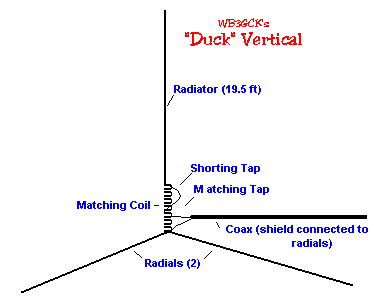 |
The Duck Vertical Craig LaBarge, WB3GCK |
 |
The Duck Vertical Craig LaBarge, WB3GCK |
[This article was originally published in the March 1998 edition of The Five Watter, the quarterly publication of the Michigan QRP Club.]
Living in a QTH with limited antenna opportunities, I have come to cherish the joys of portable QRP operation. Vacations often give me the rare opportunity to use full-size antennas and do some antenna experimenting which would be impossible at home.
In 1996, for our first vacation in the Outer Banks of North Carolina, we rented a house for a week in the little town of Duck. The house is situated on Currituck Sound and stands three stories tall with decks off of both the second and third floors. During our first year there, I used a simple dipole for 30 meters with the center of the antenna attached to the third floor deck. The results were satisfactory, but the orientation seemed narrowly-limited to the north and south. We had such a great time there that we decided to do it again the next year.
For our 1997 return trip, I knew exactly what to expect and came prepared with a new antenna to try out from this great location. This year, I used a simple base-loaded vertical which uses a 20-foot Black Widow fishing rod to support a 19.5 foot wire radiator made from #22 stranded hookup wire. I used two 19.5 foot radials (also #22 wire) which I had on hand from another antenna experiment. (Otherwise, I would have cut them for 30 meters, my primary band of interest.) The loading coil was piece of B&W 3030 coil stock from the junk box. The coil has about 29 turns of #12 AWG (8 turns per inch) and is 2.5 inches in diameter. Two clipleads were used, as shown below, to vary the coil inductance and to match the impedance to the RG-174/U miniature coax feeder. The radials and the braid from the coax were connected to the bottom of the coil. A few pieces of twine were used to secure the Black Widow fishing rod to the 3rd story deck railing, putting the base of the antenna up about 18 feet or so. And, since we were there over the 4th of July holiday, a small American flag was attached to the top of the antenna.

Tune up was pretty straight forward. First, I clipped the center conductor of the coax to the coil a few turns up from the bottom. I then varied the shorting tap for lowest SWR. I fine-tuned the match by making small adjustments to the two taps until the lowest SWR was achieved. An Autek RF Analyzer made short work of the tune-up process.
Using this arrangement, I was able to achieve a 1:1 match on both 30 meters and 40 meters, the two bands I intended to use. The antenna saw most of its action on the 30 meter band. I was amazed at well this simple antenna performed. The signal reports received during the week were consistently good. The best report I received (considering the distance involved) was from Bob, SP2EBG, who gave my little 3-watt signal a 569 report from northern Poland. I fired up the antenna once on 40 meters to ensure that I could get a match, but never really used that band. There was more than enough activity on 30 meters to keep me busy.
In addition to the nice DX chat with SP2EBG, other notable QSOs included two contacts with AB5X/9 who was operating QRP from his camp site in Indiana and my remote participation in the QRP Show and Tell which was held in Laurel, Maryland on Saturday, July 6th. During this latter QSO, I worked WA4KAC/P who was operating N3XRV's brand new SST transceiver from the parking lot in Laurel. N3XRV later sent me an email message to let me know that this was the very first QSO for his SST.
Crabbing was a little slow this year on the Sound. The locals said it was the result of an unusually cold Spring this year. No problem! When the crabs refused to cooperate, I had a ball on 30 meters.
Thanks to Dave Gauding, NF0R, creator of the Saint Louis Vertical. Although my application is quite different from Dave's original St. Louis Vertical, Dave was first to recognize how great these long fishing rods are for building lightweight, portable vertical antennas.
73, Craig WB3GCK
Notes: